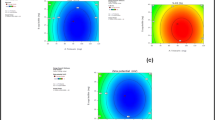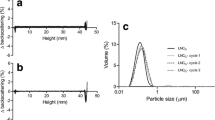Abstract
Purpose
To develop from an original process, a novel generation of stealth lipidic nanocapsules in order to improve the lipophilic drug delivery in accessible sites.
Materials and Methods
Nanocapsules covered by PEG1500 stearate were obtained by a low energy emulsification method. Conductivity measurements and ternary diagram were performed to describe the formulation mechanism. Hemolytic dosage CH50 and pharmacokinetic study in rats have been achieved in order to study the stealth properties of nanocapsules.
Results
Transition from an O/W emulsion to a w/O/W emulsion was necessary to produce PEG1500 stearate nanocapsules. Interestingly nanocapsules with a size around 26 nm and a polydispersity index inferior to 0.1 were obtained. The CH50 test has revealed a very weak complement consumption in the presence of such nanocapsules. Moreover, after intravenous injection into rats, PEG1500 stearate nanocapsules exhibited long circulating properties. The experimental data support the concept of steric repulsion of the surface towards proteins, displayed by nanocapsules covered with PEG1500 stearate. These in vivo results were in agreement with the PEG1500 density calculated at the nanocarrier surface.
Conclusions
Injectable drug carriers have been developed. Their long-circulating properties could confer them a strong potential for lipophilic drug targeting.









Similar content being viewed by others
References
C. Passirani and J. Benoit. Complement activation by injectable colloidal drug carriers. In R. I. Mahato (ed.), Biomaterials for Delivery and Targeting of Proteins and Nucleic Acids, CRC, 2005, pp. 187–230.
D. Hoarau, P. Delmas, S. x. E. p. David, E. Roux, and J.-C. Leroux. Novel long-circulating lipid nanocapsules. Pharm. Res. 21:1783–1789 (2004).
R. Gref, M. Luck, P. Quellec, M. Marchand, E. Dellacherie, S. Harnisch, T. Blunk, and R. H. Muller. ‘Stealth’ corona-core nanoparticles surface modified by polyethylene glycol (PEG): influences of the corona (PEG chain length and surface density) and of the core composition on phagocytic uptake and plasma protein adsorption. Colloids Surf., B Biointerfaces 18:301–313 (2000).
B. Heurtault, P. Saulnier, B. Pech, J. E. Proust, and J. P. Benoit. Properties of polyethylene glycol 660 12-hydroxy stearate at a triglyceride/water interface. Int. J. Pharm. 242:167–170 (2002).
K. Shinoda. The stability of O/W Type Emulsions as Functions of Temperature and the HLB of Emulsifiers: The Emulsification by PIT-Method. J. Colloid Interface Sci. 30:258–263 (1969).
T. Tadros, P. Izquierdo, J. Esquena, and C. Solans. Formation and stability of nano-emulsions. Adv. Colloid Interface Sci. 108–109:303–318 (2004).
S. Ballot, N. Noiret, F. Hindre, B. Denizot, E. Garin, H. Rajerison, and J. P. Benoit. (99m)Tc/(188)Re-labelled lipid nanocapsules as promising radiotracers for imaging and therapy: formulation and biodistribution. Eur. J. Nucl. Med. Mol. Imaging 1–6 (2006).
B. Heurtault, P. Saulnier, B. Pech, M.-C. Venier-Julienne, J.-E. Proust, R. Phan-Tan-Luu, and J.-P. Benoit. The influence of lipid nanocapsule composition on their size distribution. Eur. J. Pharm. Sci. 18:55–61 (2003).
B. a. Heurtault, P. Saulnier, B. Pech, J.-E. Proust, and J.-P. Benoit. A novel phase inversion-based process for the preparation of lipid nanocarriers. Pharm. Res. 19:875–880 (2002).
O. Lambert, N. Cavusoglu, J. Gallay, M. Vincent, J. L. Rigaud, J. P. Henry, and J. Ayala-Sanmartin. Novel organization and properties of annexin 2-membrane complexes. J. Biol. Chem. 279:10872–10882 (2004).
G. E. C. Sims and T. J. A. Snope. Method for the estimation of poly(ethylene glycol) in plasma protein fractions. Anal. Biochem. 107:60–63 (1980).
H. Ohshima. Dynamic electrophoretic mobility of a soft particle. J. Colloid Interface Sci. 233:142–152 (2001).
V. Ducel, P. Saulnier, J. Richard, and F. Boury. Plant protein-polysaccharide interactions in solutions: application of soft particle analysis and light scattering measurements. Colloids Surf., B Biointerfaces 41:95–102 (2005).
W. Wang, K. Okamoto, J. Rounds, E. Chambers, and D. O. Jacobs. In vitro complement activation favoring soluble C5b-9 complex formation alters myocellular sodium homeostasis. Surgery 129:209–219 (2001).
M. T. Peracchia, C. Vauthier, C. Passirani, P. Couvreur, and D. Labarre. Complement consumption by poly(ethylene glycol) in different conformations chemically coupled to poly(isobutyl 2-cyanoacrylate) nanoparticles. Life Sci. 61:749–761 (1997).
F. Mevellec, F. Tisato, F. Refosco, A. Roucoux, N. Noiret, H. Patin, and G. Bandoli. Synthesis and characterization of the “sulfur-rich” bis(perthiobenzoato)(dithiobenzoato)technetium(III) heterocomplex. Inorg. Chem. 41:598–601 (2002).
J. Allouche, E. Tyrode, V. Sadtler, L. Choplin, and J. L. Salager. Simultaneous conductivity and viscosity measurements as a technique to track emulsion inversion by the phase-inversion-temperature method. Langmuir 20:2134–40 (2004).
W. D. Bancroft. The theory of emulsification. J. Phys. Chem. 17: (1913).
J. Allouche, E. Tyrode, V. Sadtler, L. Choplin, and J. L. Salager. Single and two steps emulsification to prepare a persistent multiple emulsion with a surfactant-polymer mixture. Ind. Eng. Chem. Res. 42:3982–3988 (2003).
S. Marfisi, M. P. Rodriguez, G. Alvarez, M.-T. Celis, A. Forgiarini, J. Lachaise, and J.-L. Salager. Complex emulsion inversion pattern associated with the partitioning of nonionic surfactant mixtures in the presence of alcohol cosurfactant. Langmuir 21:6712–6716 (2005).
J. L. Salager, M. Minana-Perez, M. Perez-Sanchez, M. Ramirez-Gouveia, and C. I. Rojas. Surfactant-oil-water systems near the affinity inversion. Part III. The two kinds of emulsion inversion. J. Dispers. Sci. Technol. 4:313–329 (1983).
M. C. E. Van Hecke, J. Poprawski, J.-M. Aubry,and J.-L. Salager,. A novel criterion for studying the phase equilibria of non-ionic surfactant-triglyceride oil-water systems. Polym. Int. 52:559–562 (2003).
J. Poprawski, M. Catte, L. Marquez, M.-J. Marti, J.-L. Salager, and J.-M. Aubry. Application of hydrophilic–lipophilic deviation formulation concept to microemulsions containing pine oil and nonionic surfactant. Polym. Int. 52:629–632 (2003).
A. Wadle, T. Forster, and W. von Rybinski. Influence of the microemulsion phase structure on the phase inversion temperature emulsification of polar oils. Colloids Surf., A Physicochem. Eng. Asp. 76:51–57 (1993).
D. Morales, J. M. Gutiérrez, M. J. García-Celma, and Y. C. Solans. A study of the relation between bicontinuous microemulsions and oil/water nano-emulsion formation. Langmuir 19:7196–7200 (2003).
A. Vonarbourg, C. Passirani, P. Saulnier, and J. P. Benoit. Evaluation of pegylated lipid nanocapsules versus complement system activation and macrophage uptake. J. Biomed. Mater. Res. A In Press: (2006).
T. Ishida, H. Harashima, and H. Kiwada. Liposome clearance. Bios. Rep. 22:197–224 (2002).
H. Harashima, K. Sakata, K. Funato, and H. Kiwada. Enhanced hepatic uptake of liposomes through complement activation depending on the size of liposomes. Pharm. Res. 11:402–406 (1994).
S. M. Moghimi and J. Szebeni. Stealth liposomes and long circulating nanoparticles: critical issues in pharmacokinetics, opsonization and protein-binding properties. Prog. Lipid Res. 42:463–478 (2003).
S. I. Jeon, J. H. Lee, J. D. Andrade, and P. G. De Gennes. Protein-surface interactions in the presence of polyethylene oxide. I. Simplified theory. J. Colloid Interface Sci. 142:149–158 (1991).
I. Minkov, T. Ivanova, I. Panaiotov, J. Proust, and P. Saulnier. Reorganization of lipid nanocapsules at air-water interface. I. Kinetics of surface film formation. Colloids Surf., B Biointerfaces 45:14–23 (2005).
V. G. Ivkov and G. N. Berestovskii. Conformation of hydrocarbon chains in a lipid bilayer. Biofizika 24:633–636 (1979).
J. M. Smaby, W. J. Baumann, and H. L. Brockman. Lipid structure and the behavior of cholesteryl esters in monolayer and bulk phases. J. Lipid Res. 20:784–8 (1979).
M. Vittaz, D. Bazile, G. Spenlehauer, T. Verrecchia, M. Veillard, F. Puisieux, and D. Labarre. Effect of PEO surface density on long-circulating PLA-PEO nanoparticles which are very low complement activators. Biomaterials 17:1575–1581 (1996).
A. Vonarbourg, P. Saulnier, C. Passirani, and J. P. Benoit. Electrokinetic properties of noncharged lipid nanocapsules: influence of the dipolar distribution at the interface. Electrophoresis 26:2066–75 (2005).
A. Mori, A. L. Klibanov, V. P. Torchilin, and L. Huang. Influence of the steric barrier activity of amphipathic poly(ethyleneglycol) and ganglioside GM1 on the circulation time of liposomes and on the target binding of immunoliposomes in vivo. FEBS Lett. 284:263–266 (1991).
R. Gref, Y. Minamitake, M. T. Peracchia, V. Trubetskoy, V. Torchilin, and R. Langer. Biodegradable long-circulating polymeric nanospheres. Science 263:1600–3 (1994).
J.-C. Leroux, E. Allemann, F. De Jaeghere, E. Doelker, and R. Gurny. Biodegradable nanoparticles—from sustained release formulations to improved site specific drug delivery. J. Control. Release 39:339–350 (1996).
J.-C. Leroux, F. De Jaeghere, B. Anner, E. Doelker, and R. Gurny. An investigation on the role of plasma and serum opsonins on the internalization of biodegradable poly(d,l-lactic acid) nanoparticles by human monocytes. Life Sciences 57:695–703 (1995).
V. C. F. Mosqueira, P. Legrand, J.-L. Morgat, M. Vert, E. Mysiakine, R. Gref, J.-P. Devissaguet, and G. Barratt. Biodistribution of long-circulating PEG-grafted nanocapsules in mice: effects of PEG chain length and density. Pharm. Res. 18:1411–1419 (2001).
S. I. Jeon, J. H. Lee, J. D. Andrade, and P. G. De Gennes. Protein-surface interactions in the presence of polyethylene oxide. I. Simplified theory. J. Colloid Interface Sci. 142:149–158 (1991).
B. B. Lundberg, B.-C. Mortimer, and T. G. Redgrave. Submicron lipid emulsions containing amphipathic polyethylene glycol for use as drug-carriers with prolonged circulation time. Int. J. Pharm. 134:119–127 (1996).
Acknowledgments
The authors thank O. Lambert for Cryo-TEM studies (UMR-CNRS 5471, Bordeaux, F−33405 France; Université de Bordeaux 1, Bordeaux, F-33405 France). We also want to thank Andréanne Bouchard (University of Technology, Delft, NL-2600 AA The Netherlands) for her valuable comments and suggestions. This work was supported by the departmental committee of Maine-et-Loire of “Ligue contre le cancer.”
Author information
Authors and Affiliations
Corresponding author
Rights and permissions
About this article
Cite this article
Béduneau, A., Saulnier, P., Anton, N. et al. Pegylated Nanocapsules Produced by an Organic Solvent-Free Method: Evaluation of their Stealth Properties. Pharm Res 23, 2190–2199 (2006). https://doi.org/10.1007/s11095-006-9061-y
Received:
Accepted:
Published:
Issue Date:
DOI: https://doi.org/10.1007/s11095-006-9061-y




